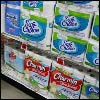Session Overview

|
Everyone knows the unpleasant feeling that results from the price of something you’ve been longing to buy increasing – or the excitement of seeing your favorite snack go on sale! When the price of a good changes, consumers’ demand for that good changes. We can understand these changes by graphing supply and demand curves and analyzing their properties. Toilet paper is an example of an elastic good. Image courtesy of Nic Stage on Flickr. |
Keywords: Elasticity; revenue; empirical economics; demand elasticity; supply elasticity.
Session Activities
Readings
Before watching the lecture video, read the course textbook for an introduction to the material covered in this session:
- [R&T] Chapter 5, “Elasticity: A Measure of Response.”
- [Perloff] Chapter 3, “Applying the Supply-and-Demand Model.” (optional)
Lecture Videos
Resources
Further Study
Question 1
Which of the following accurately characterize perfectly inelastic demand?
A vertical demand curve means that if the supply curve shifts, only the price changes; there is no change in quantity demanded.
Question 2
When do we expect to see a perfectly elastic demand curve?
When a good has a perfect substitute (for example, hamburgers at different fast food chains), then if there is a price increase at one store, consumers will simply switch to purchasing from another store. This results in a perfectly elastic demand curve. A good that has no substitutes will have perfectly inelastic demand. The existence of complementary goods and the nature of the supply curve do not affect the elasticity of demand.
Question 3
Lets say a researcher makes a study of patients in hospitals and finds they are much sicker than the average person in the population. Then he concludes that hospitals make patients sick. The researcher is mixing up two concepts; what are they?
Being in the hospital is correlated with being ill, because primarily ill patients are admitted to the hospital, but this is not the cause of the illness. The primary challenge of empirical economics is to distinguish correlation and causation.
Question 4
If the elasticity of demand for a good is sufficiently negative, firms may actually lose revenues when they raise the price of the good. Why is this?
The elasticity of demand does not change when price changes, and we have not discussed any change on the supply side. If revenue is declining that means that consumers are shifting away from this firms good (now that is newly expensive) and purchasing goods made by other firms, not vice versa.
Question 5
What is an example of a supply shock in the orange market that would enable us to estimate demand elasticity?
Any shock to the supply of a good caused by weather or government policy will shift the supply curve, and this will allow us to use the resulting changes in price and quantity sold to estimate the elasticity of demand.








